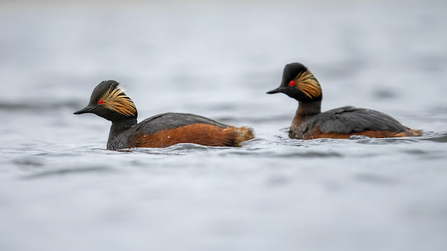
A pair of black-necked grebes showed wonderfully well
Photo credit: @Elliott81758817
Yellow wagtails brightened the month pics (above)
Photo credit: @Elliott81758817 and @IvorHewstone

A pair of black-necked grebes showed wonderfully well
Photo credit: @Elliott81758817
In all 98 species were seen across the month including 19 new for the year. The additions take the year list to 118 which is just one behind last year and six ahead of 2022. Among the missing species so far are Pheasant and Rook as well as Garganey, Mediterranean Gull and Black-tailed Godwit as well as both Black and Common Redstart.
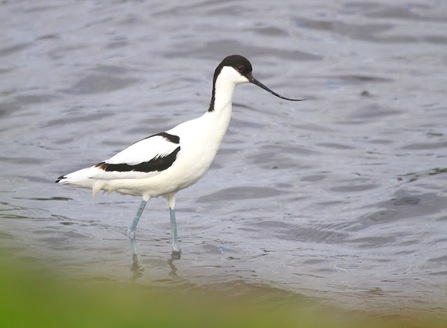
An avocet unusually spent three days at the Wetlands
Photo credit: @Chris_Farthing
Barnacle geese may again be breeding with at least one pair regularly on the large island on No 5 and up to nine more counted feeding around the reservoir. Shelduck, too, look as if they are attempting to nest with birds seen around the islands on High Maynard, No 1 and No 3. A pair of shoveler remained until at least the 24th, a day later than last year, while a couple of pairs of Teal also stayed into May,
Black-necked grebes passing through in Spring are expected but their arrival in full-breeding finery is still one of the joys of the birding year at the Wetlands. The stunning pair found by CF on Lockwood on the 26th were even tamer and long-staying than usual, giving wonderful views until the end of the month.
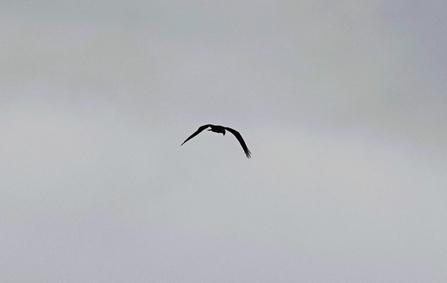
Osprey trying to head north unseen
Photo credit: @LolBodini
Osprey is just about annual at the Wetlands although dedicated sky-watching would likely turn up more. In fact, the bird probably brought low by one of the many heavy showers this month almost slipped past unseen on the 19th. Red kites were seen regularly with two on 16th and singles on at least five other days while common buzzards were recorded on three days. The second short-eared owl of the year flew around High Maynard and then north on the 19th.
A pair of avocets resting on Lockwood pic
Photo credit: @sjnewton
April continued the good year for waders with 10 species seen which included the biggest flock - other than lapwing - since 21 Knot back in 1992. Single oystercatchers, which can nest nearby, were seen on the 7th, 10th, 13th and 22nd. Avocet is normally a 'catch it if you can' visitor to the Wetlands with stays of a few hours, if not minutes, the norm. So the two that spent the whole of the 23rd on Lockwood were unusual enough but for one to remain, despite continual disturbance from mowers, for the next two days was very surprising.
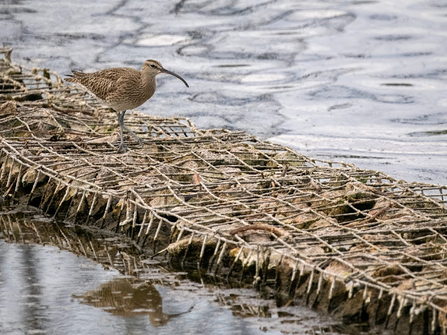
One of seven whimbrel seen this month
Photo credit: @Elliott81758817
After the March bird, little ringed plover were seen much more frequently than last year's three sightings with records on the 6th and 19th followed by perhaps the same bird on Lockwood for five days from the 23rd and again on the 29th. Late April is the best month for whimbrel but they are often only seen flying north as was the case with four on the 28th. But this year three separate birds also dropped in to rest and feed on Lockwood with records on the 19th, 22nd and a tame individual all day on the 26th. It is a good month for curlew as well with two on the 5th which landed for a time on the playing fields by No 4 with another next day,
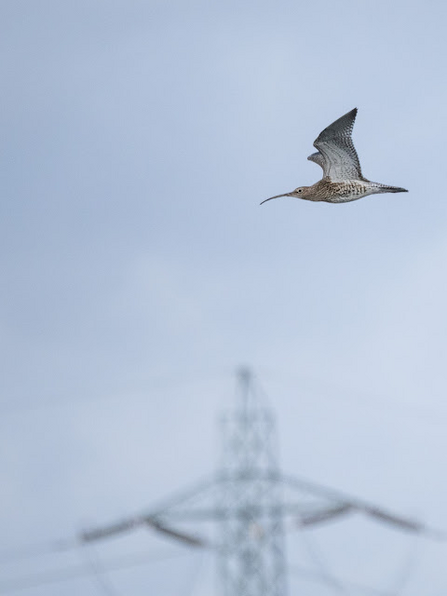
Curlew were seen on two days
Photo credit: @Elliott81758817
The second bar-tailed godwit of the year was part of an extraordinary flock of waders which sat out the rain and wind of the 28th on the relatively sheltered west side of Lockwood. The flock also included two summer-plumaged dunlin with others being seen on the 4th and 27th. But the bulk of the wader flock were 16 redshank first found - with the Dunlin - together on East Warwick before relocating to Lockwood. Redshank records are usually of singles like the bird on the 23rd or a pair but 16 is far more than will be seen collectively across most years. The first greenshank of the year was also found on the 28th on West Warwick before going north.
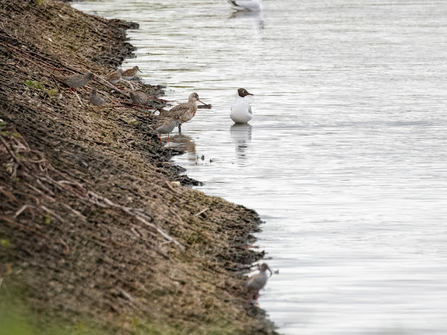
Bar-tailed godwit, redshank and dunlin on Lockwood
Photo credit: @ Elliott81758817
Our wintering common sandpiper hung around High Maynard until mid-month by which time the first passage birds were moving through. A second bird was seen on the 4th with numbers building towards the month's end with a maximum count of eight on the 29th.
If it was good for waders, it was a little disappointing for gulls. No Mediterranean Gulls or Kittiwakes were seen and the only little gulls, despite the good conditions, were five adults briefly on Lockwood on the 27th. But it was a much better story with terns. Sandwich tern, unusually, was not recorded at all last year but to make up for the omission, singles were seen on both the 6th and 7th.
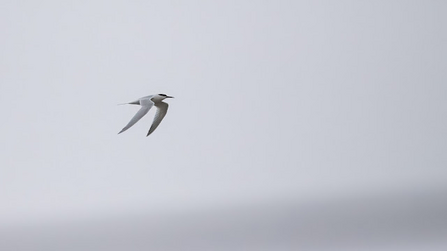
Sandwich tern over No 5
Photo credit: @Elliott81758817
Nationally one of the features of April was a remarkable inland passage of arctic terns towards the end of the month in which the Wetlands shared. The first two were found on the 16th - nine days earlier than last year - with two more on the 19th and a single on the 20th. Passage then picked up with at least 15 on the 21st followed by a very conservative count of 25 on the 23rd when a staggering 200 were on Staines Reservoir. Ten more were seen on the 27th and 12 on the 28th with the odd bird until the end of the month.
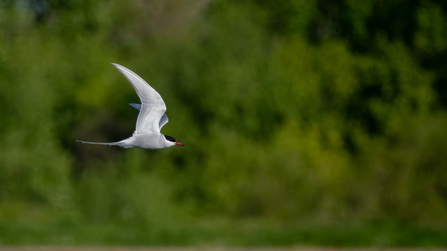
It was an excellent month for arctic tern passage
Photo credit: @Elliott81758817
After the early common tern in March, two more were seen on the 7th and another on the 12th before, from their excitable behaviour, breeding birds arrived back on both Lockwood and East Warwick on the 16th - four days earlier than last year. The end of the month also saw groups of Common Terns drop in with the passing Arctics.
The first swift of the year was seen on the 16th, four days ahead of last year and nine days ahead of 2022. Both swallow and house martin last year appeared before the end of March but this year Swallow was not seen until the 5th with the first house martin two days later. Skylarks were recorded on the 8th and 26th.
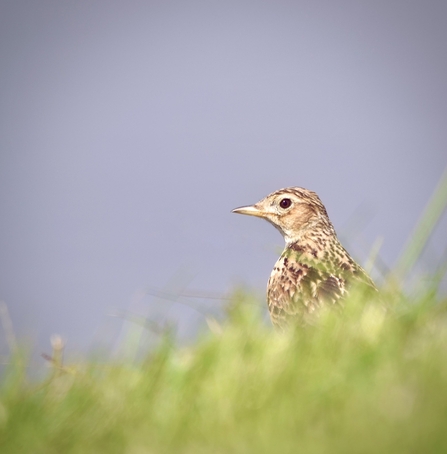
A skylark dropped onto Lockwood
Photo credit: @HarringayBirder
Despite the unfavourable weather, our breeding warblers arrived earlier than last year. The first reed warbler was on the 7th (11th last year), sedge warbler on the 5th (8th), common whitethroat on the 8th (11th) and lesser whitethroat on the 13th (25th). Numbers were slow to build up although there was a big influx of Reed Warblers by the end of the month which also saw four Lesser Whitethroats on territory across the site. The northerly airstream held willow warblers, which don't nest at.the Wetlands, longer here with records until at least the 24th and 10+ singing birds on several days mid-month.
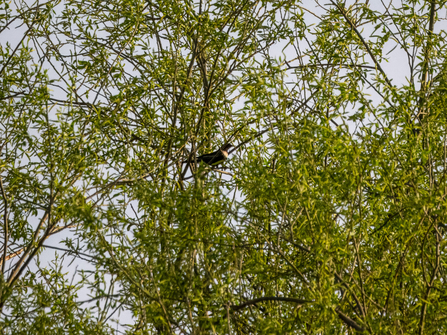
The only ring ouzel made a very brief appearance
Photo credit: @Elliott81758817
The only ring ouzel of the Spring so far was the flighty male found on the south side by SD on the 6th. This was better than Common Redstart which, after five individuals were seen last April, was not recorded at all. Whinchat fared little better with just a single bird on the 28th,- four days later than the two males which arrived last year and almost two weeks later than in 2022. Nor did the weather patterns seem good for wheatear with the peak count just four - far below the highest total of 10+ last April - with several periods of days where none were seen.
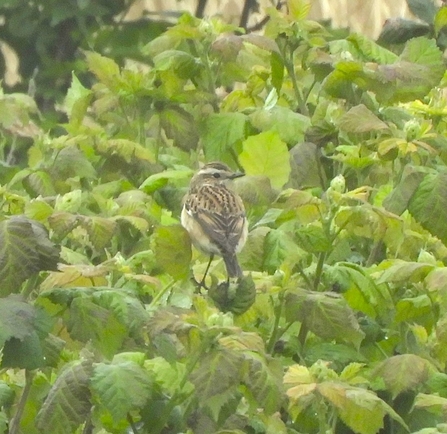
April's sole whinchat appeared in the rain
Photo credit: @porthkillier
In contrast, it was a good month for yellow wagtails with close to 40 birds over on nine days. The first was seen on the 7th - two days earlier than last year and two weeks ahead of 2022 - with ones or two seen regularly until the end of the month although most were just flying over. This changed in the murky conditions of the 27th when around 25 were seen including flocks of nine and 12 on the ground.
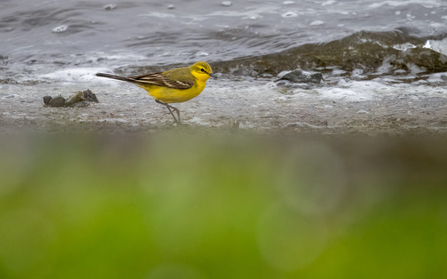
Yellow wagtails brightened the month pics (above)
Photo credit: @Elliott81758817 and @IvorHewstone
Meadow Pipits passed over in small numbers throughout the month with eight on the 7th. DDL had a tree pipit - a genuinely scarce visitor - over Lockwood on the 23rd. There were no April Bramblings this year but a late siskin went west on the 7th.